*NURSING > EXAM > RNSG 1430 Exam 3 2020 – San Antonio College | RNSG1430 Exam 3 2020 – San Antonio College (All)
RNSG 1430 Exam 3 2020 – San Antonio College | RNSG1430 Exam 3 2020 – San Antonio College
Document Content and Description Below
RNSG 1430 Exam 3 2020 – San Antonio College Objective & Integrated Process & Concept Exemplar . Identify when nutrition imbalance (negative consequence) is developing ... 7. Demonstrate basic nursing measures to promote necessary optimal nutritional balance, dependent on patient needs related to health risks, illness or disorder; alterations of physiological-psychological function. 9. Educate-Teach overweight and obese patients the importance of lifestyle changes to promote health. Nursing Process: Planning 1- Nutritional assessment NUTRITION Taylor: Ch. 35 Principles of Nutrition 1195-1208 Ch. 35 Factors Affecting Nutrition 1209-25 Hinckle: Ch. 11 Age related changes 186-9 Ch. 5 Nutritional Assessment 69-74 Ch. 7 Transcultural Nursing, Diet 100 Ch. 33 Management of Patients with Nonmalignant Hematologic Disorders, Anemia 900-6 Ch. 45 Maintaining Feeding Equipment & Nutritional Balance 1229-34 Ch. 67 Dysphagia 1984-85 Patho Ch. 10 Overweight and Obesity 231-4 Ch. 10 Undernutrition and Eating Disorders 234- 7 ATI Fundamentals for Nursing Ch. 39 - - - - -- -- - - - - - - - - -3. Identify when nutrition imbalance (negative consequence) is developing 7. Demonstrate basic nursing measures to promote necessary optimal nutritional balance, dependent on patient needs related to health risks, illness or disorder; alterations of physiological-psychological function. 9. Educate-Teach overweight and obese patients the importance of lifestyle changes to promote health. Nursing Process: Planning 1- Nutritional assessment NUTRITION Taylor: Ch. 35 Principles of Nutrition 1195-1208 Ch. 35 Factors Affecting Nutrition 1209-25 Hinckle: Ch. 11 Age related changes 186-9 Ch. 5 Nutritional Assessment 69-74 Ch. 7 Transcultural Nursing, Diet 100 Ch. 33 Management of Patients with Nonmalignant Hematologic Disorders, Anemia 900-6 Ch. 45 Maintaining Feeding Equipment & Nutritional Balance 1229-34 Ch. 67 Dysphagia 1984-85 Patho Ch. 10 Overweight and Obesity 231-4 Ch. 10 Undernutrition and Eating Disorders 234- 7 ATI Fundamentals for Nursing Ch. 39 Nutritional status has a significant impact on both health and disease. For well patients, good nutritional status can help to maintain health, promote normal growth and development, and protect against disease. During illness, good nutritional status can reduce the risk for complications and speed recovery time. Conversely, poor nutritional status can increase the risk for illness or death. Like other aspects of nursing care, nutritional assessment is a systematic approach used to identify the patient’s actual or potential needs, formulate a plan to meet those needs, initiate the plan or assign others to implement it, and evaluate the effectiveness of the plan. The level of assessment may range from simple screening to a comprehensive, in-depth assessment, depending on individual circumstances. Regardless of the level of assessment, nutritional assessment is appropriate for all patients. Nurses can collect assessment data through history taking (dietary, medical, socioeconomic data), physical assessments (anthropometric and clinical data), and laboratory data. When performing a nutritional assessment, nurses need to be aware of the specific changes in older people that may reflect on the accuracy of the assessment process (T 1214) Nutritional screening is an important part of the nursing assessment. Screening looks for cues associated with nutrition problems to determine if a person is malnourished or at risk for malnutrition. The Mini Nutritional Assessment tool (MNA) is an example of a screening tool used to detect older adults at risk for malnutrition before changes in albumin level and the BMI. The MNA is a combination of screening questions followed by anthropometric measurements, including BMI, midarm and calf circumference, and weight loss. The MNA is fast and easy, and recommended for use with all older adult patients, whether they are community dwelling, hospitalized, or in long-term care settings After a screening tool identifies a patient at risk, such as in a group of older adults, it is imperative to complete a nutritional assessment as a follow-up. These patients are usually referred to a dietitian for a comprehensive nutritional assessment. When this is combined with other methods of assessing nutritional status, the nurse is better prepared to coordinate a focused strategy to combat malnutrition.(T1214) Nursing process: assessment 3 basic components: Nutritional history- incudes: Age, sex, activity level Difficulty eating – chewing, swallowing, mouth, teeth, dentures Changes in appetite and weight Physical disabilities that affect purchasing, preparing and eating food Cultural/religious beliefs that affect food choices•Living arrangements/socioeconomic issues Medical condition, medication history Physical exam Diagnostic and lab data Nursing Management: assessment Nutritional Assessment and Screening: Purpose Performed to identify patients at risk for malnutrition or with poor nutritional status Carry out nutritional screens through routine nursing histories and physical exams Patients found to be at moderate or high risk are followed with a comprehensive assessment by a dietician Nursing homes residents whose percent of meals eaten falls below 75% receive a full nutritional assessment by a nurse DETERMINE can be used to screen for warning signs of poor nutritional health: Disease: any disease, illness or chronic condition that causes a change in appetite Eating poorly: eating too little or too much Tooth loss/mouth pain: missing, loose, or rotten teeth or dentures that don’t fit well Economic hardship: having less or choosing to spend less on food Reduced social contact: being with people has a positive effect on eating Multiple Medicines: polypharmacyInvoluntary Weight Loss/Gain Needs Assistance in Self-Care Elder Years Above Age 80 Nursing history Physical examination Calculating percentage of weight loss Dietary history Anthropometric measurements: Measuring triceps skinfold: measures body composition Measuring mid-arm circumference Measuring skinfold Laboratory data Serum protein Prealbumin “gold standard” in assessing possible protein malnutrition responses to rapid changes Low serum albuminn idicates prolonged protein depletion (could also be indicative of altered liver function, hydration status, and losses from open wounds and burns) Hemoglobin (may be evidence of Fe deficiency anemia) Total Iron Binding Capacity (TIBC) – carries Fe from intestine through serum (measures protein depletion through transferrin) 1. Define the concept of nutrition (including definition, antecedents, and attributes). 2. Review physical assessment and nursing interview-history of patients experiencing adequate nutritional findings. 3. Identify when nutrition imbalance (negative consequence) is developing 2- Nutritional assessment Nursing Process Assessment intervention 3. Identify when nutrition imbalance (negative consequence) is developing 6. Formulate and apply the nursing process including appropriate goals, interventions (including collaborative interventions) for individuals experiencing problems with nutrition imbalance (negative consequences). 3- Nutritional assessment/attributes, antecedents Nursing Process assessment - - - - - - - - - - - - -- - - - - - - -- 1. Define the concept of nutrition (including definition, antecedents, and attributes). 2. Review physical assessment and nursing interview-history of patients experiencing adequate nutritional findings. 3. Identify when nutrition imbalance (negative consequence) is developing 2- Nutritional assessment Nursing Process Assessment intervention 3. Identify when nutrition imbalance (negative consequence) is developing 6. Formulate and apply the nursing process including appropriate goals, interventions (including collaborative interventions) for individuals experiencing problems with nutrition imbalance (negative consequences). 3- Nutritional assessment/attributes, antecedents Nursing Process assessment 4. Identify which conditions place a patient at risk for nutrition imbalance. 4- Nutrition Evaluating dietary information/ guidelines Teaching & Learning, Patient Education 2. Review physical assessment and nursing interview-history of patients experiencing adequate nutritional findings. 3. Identify when nutrition imbalance (negative consequence) is developing 5- Nutrition Physical, Sociocultural, and Psychosocial Factors That Influence Food Choices Assessment (t1212) 3. Identify when nutrition imbalance (negative consequence) is developing 7. Demonstrate basic nursing measures to promote necessary optimal nutritional balance, dependent on patient needs related to health risks, illness or disorder; alterations of physiological-psychological function. 9. Educate-Teach overweight and obese patients the importance of lifestyle changes to promote health. 6- Nutrition Macro/micro nutrients Assessment 3. Identify when nutrition imbalance (negative consequence) is developing 7. Demonstrate basic nursing measures to promote necessary optimal nutritional balance, dependent on patient needs related to health risks, illness or disorder; alterations of physiological-psychological function. 7- Nutrition Purpose of Biochemical assessment Nursing Process Assessment and Intervention Biochemical (Laboratory) Data Nitrogen balance Reflects the status of protein nutrition in the body Net result of intake and loss of nitrogen When nitrogen intake equals nitrogen output, a state of nitrogen balance exist Total lymphocyte count the total number of lymphocytes decrease as protein decreases Protein calorie malnutrition can depress the immune system What is the main difference between albumin & prealbumin? Albumin- most useful when used to monitor long term nutrition changes in protein (sometimes normal values are still found among patients who are recently malnourished (10-14 day half life) Prealbumin- monitors short term protein status b/c of short half life (2days) Urea (BUN 10-20 mg/dL) Chief end product of amino acid metabolism Excreted by kidneys Urea in the blood and urine directly reflect the intake and breakdown of dietary protein Urine Creatinine Excretion (0.7-1.4 mg/dL) Creatinine is the product of muscle creatinine catabolism, the greater the muscle mass, the greater the excretion of creatinine Influenced by protein intake, exercise, age, sex, height, renal function and thyroid function 1. Define the concept of nutrition (including definition, antecedents, and attributes). 6. Formulate and apply the nursing process including appropriate goals, interventions (including collaborative interventions) for individuals experiencing problems with nutrition imbalance (negative consequences). 8- Nutritional assessment Risk factors Nursing Process Teaching learning - - - - - - - - - - - - - - - - - 5. Discuss exemplars of common nutrition disorders. (See above). 6. Formulate and apply the nursing process including appropriate goals, interventions (including collaborative interventions) for individuals experiencing problems with nutrition imbalance (negative consequences). 7. Demonstrate basic nursing measures to promote necessary optimal nutritional balance, dependent on patient needs related to health risks, illness or disorder; alterations of physiological-psychological function. 17- Nutrition/ Iron Deficiency Anemia Teaching & Learning, Intervention 5. Discuss exemplars of common nutrition disorders. 6. Formulate and apply the nursing process including appropriate goals, interventions (including collaborative interventions) for individuals experiencing problems with nutrition imbalance (negative consequences). 7. Demonstrate basic nursing measures to promote necessary optimal nutritional balance, dependent on patient needs related to health risks, illness or disorder; alterations of physiological-psychological function 18- Nutrition Assessment Assessment 5. Discuss exemplars of common nutrition disorders. 6. Formulate and apply the nursing process including appropriate goals, interventions (including collaborative interventions) for individuals experiencing problems with nutrition imbalance (negative consequences). 7. Demonstrate basic nursing measures to promote necessary optimal nutritional balance, dependent on patient needs related to health risks, illness or disorder; alterations of physiological-psychological function. 19- Nutrition-age related changes Nursing Process intervention 5. Apply the nursing process (including collaborative interventions) for individuals experiencing Tissue Integrity imbalance and to promote normal Tissue Integrity. Identify when Tissue Integrity imbalance (negative consequence) is developing or has developed. 20- Tissue Integrity-Dressings Nursing Process Intervention (T 985) 7. Demonstrate basic nursing measures to promote necessary optimal nutritional balance, dependent on patient needs related to health risks, illness or disorder; alterations of physiological-psychological function. 21- Nutrition/ Obesity Nursing Process, Teaching Learning 5. Discuss exemplars of common nutrition disorders. 6. Formulate and apply the nursing process including appropriate goals, interventions (including collaborative interventions) for individuals experiencing problems with nutrition imbalance (negative consequences). 7. Demonstrate basic nursing measures to promote necessary optimal nutritional balance, dependent on patient needs related to health risks, illness or disorder; alterations of physiological-psychological function. 22- Nutrition/ Nutritional assessment in the older adult Nursing Process Intervention 5. Discuss exemplars of common nutrition disorders. 6. Formulate and apply the nursing process including appropriate goals, interventions (including collaborative interventions) for individuals experiencing problems with nutrition imbalance (negative consequences). 7. Demonstrate basic nursing measures to promote necessary optimal nutritional balance, dependent on patient needs related to health risks, illness or disorder; alterations of physiological-psychological function. 23-Nutrition/Nutritional assessment in the older adult Nursing Process intervention 1. Define the concept of nutrition (including definition, antecedents, and attributes). 24-Nutrition/ Vegetarian teaching learning Nursing Process Teaching learning (T1224) 5. Discuss exemplars of common nutrition disorders. (See above). 6. Formulate and apply the nursing process including appropriate goals, interventions (including collaborative interventions) for individuals experiencing problems with nutrition imbalance (negative consequences). 25-Tissue Integrity- wound healing Nursing Process Evaluation T 970 4. Discuss exemplars of common elimination disorders. 5. Apply the nursing process (including collaborative interventions) for individuals experiencing disruptions in elimination and to promote normal elimination. 26- Elimination/ Urinary incontinence (TAYLOR) (H1623) Intervention Teaching learning ELIMINATION Taylor: Ch. 36 Urinary Elimination 1265-9 Ch. 36 Nursin Process for urinary elimination 1280-98 Ch. 37 Bowel Elimination 1349-51 Ch. 37 Nursing Process for Bowel Elimination 1354-82 Patho: Ch. 39: Disorders of the Male genitourinary system 1009-12 Hinkle: Ch. 53: Assessment of Kidney & Urinary Function 1507-24 Ch. 55: Adult Voiding, Dysfunction 1582-91 Ch. 48: Management of Patients with Intestinal and rectal disorders 1316-18 Ch. 48: Management of Patients with Intestinal and Rectal Disorders: Constipation and Diarrhea 1286-91 Ch. 59: Assessment and Management of Problems related to Male Reproductive Processes 1723-25 2. Analyze conditions which place a patient at risk for disruptions in elimination. 27- Elimination / Bowel incontinence Intervention 5. Apply the nursing process (including collaborative interventions) for individuals experiencing disruptions in elimination and to promote normal elimination. 28- Elimination / Urge incontinence Assessment (CH 53) 2. Analyze conditions which place a patient at risk for disruptions in elimination. 29- Elimination / age related changes Nursing Process Intervention 2. Analyze conditions which place a patient at risk for disruptions in elimination. 3. Identify when elimination disruptions (negative consequence) are developing or have developed. 30-Elimination / Urinary intervention - - - - -- - - - - - - - - - - - - - - - - - - - -- 5. Apply the nursing process (including collaborative interventions) for individuals experiencing disruptions in elimination and to promote normal elimination. 39-Elimination / Kidney & Urinary Function Risk factors for urinary retention Teaching & Learning 3.Identify when elimination disruptions (negative consequence) are developing or have developed. 5. Apply the nursing process (including collaborative interventions) for individuals experiencing disruptions in elimination and to promote normal elimination. 40-Elimination / Cleansing enema intervention (P1364) intervention 5. Apply the nursing process (including collaborative interventions) for individuals experiencing disruptions in elimination and to promote normal elimination. 41-Elimination / risk diagnosis (T CH 53) P 1555 Teaching & Learning 1.Explain the concept of elimination (including definition, antecedents, and attributes). 2.Analyze conditions which place a patient at risk for disruptions in elimination. 42-Elimination / Bowel elimination Teaching learning 4. Discuss exemplars of common elimination disorders. 5. Apply the nursing process (including collaborative interventions) for individuals experiencing disruptions in elimination and to promote normal elimination. 43-Elimination / Diarrhea (1314 HINKLE) Teaching learning interventions 1.Explain the concept of elimination (including definition, antecedents, and attributes). 2.Analyze conditions which place a patient at risk for disruptions in elimination. 44-Elimination / Fecal impaction Nursing Process Intervention 5. Apply the nursing process (including collaborative interventions) for individuals experiencing disruptions in elimination and to promote normal elimination. 45-Elimination / Physical assessment of the GI system Critical Thinking 3.Identify when elimination disruptions (negative consequence) are developing or have developed. 46-Elimination / Kidney & Urinary Function Assessment 3.Identify when elimination disruptions (negative consequence) are developing or have developed. 47-Elimination / Clostridium Difficile Teaching learning 2.Analyze conditions which place a patient at risk for disruptions in elimination. 48-Elimination /diarrhea Assessment 2.Analyze conditions which place a patient at risk for disruptions in elimination. 49-Elimination/ bowel training Teaching learning Intervention 5. Apply the nursing process (including collaborative interventions) for individuals experiencing disruptions in elimination and to promote normal elimination. 50- Priority assessment with elimination problems Teaching learning [Show More]
Last updated: 1 year ago
Preview 1 out of 45 pages
Instant download
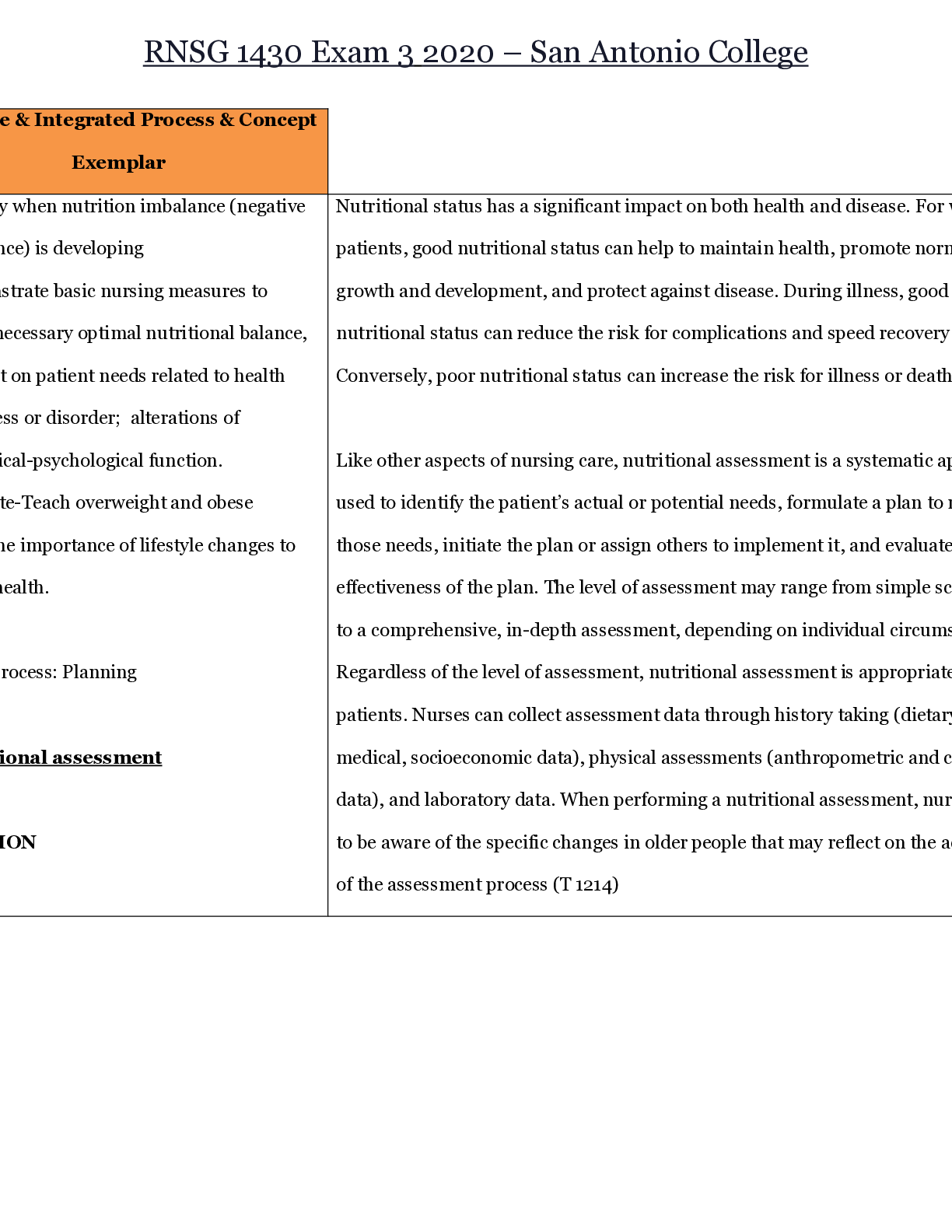
Buy this document to get the full access instantly
Instant Download Access after purchase
Add to cartInstant download
Reviews( 0 )
Document information
Connected school, study & course
About the document
Uploaded On
Nov 01, 2020
Number of pages
45
Written in
Additional information
This document has been written for:
Uploaded
Nov 01, 2020
Downloads
0
Views
121













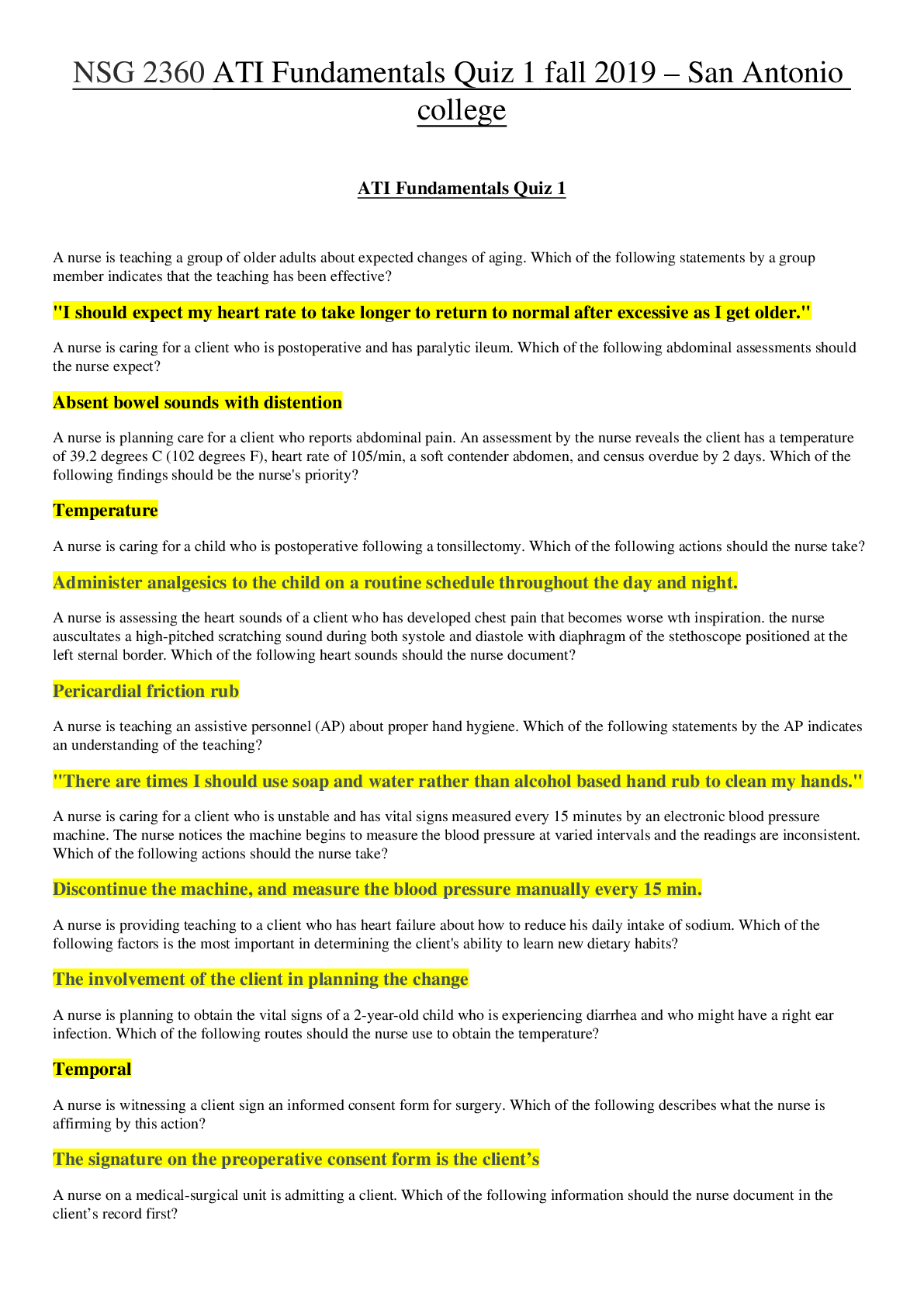

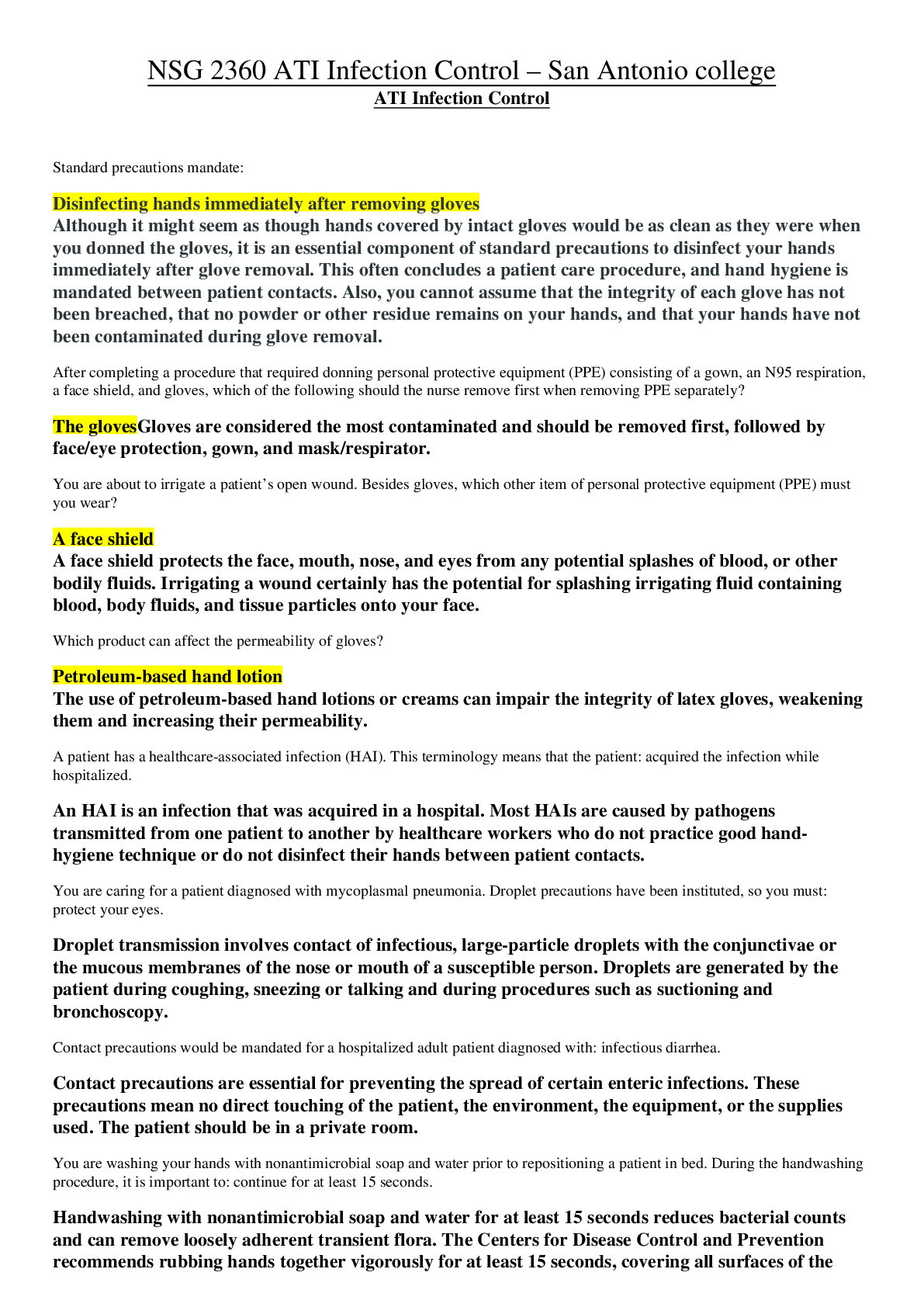
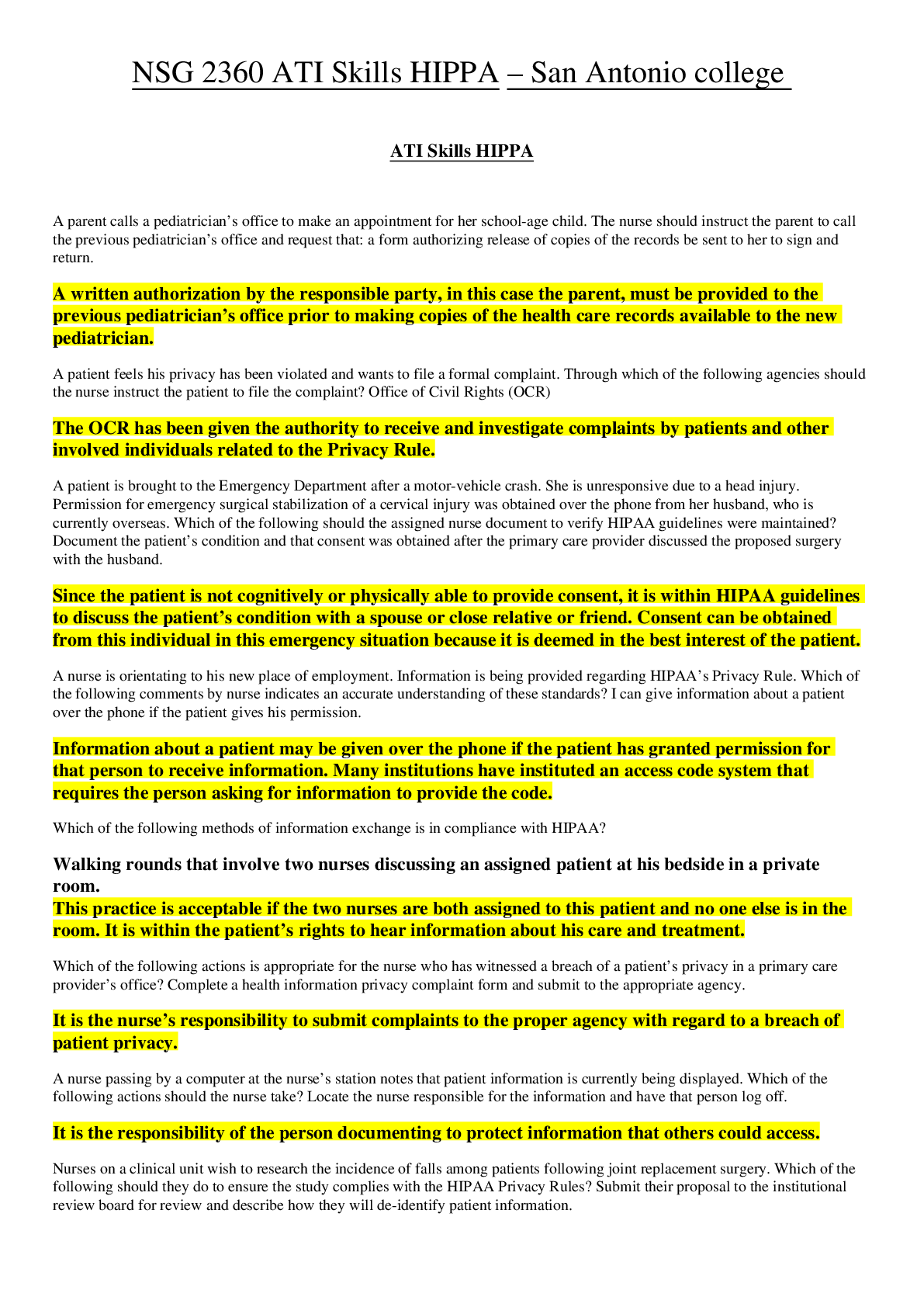
 – El Centro College.png)

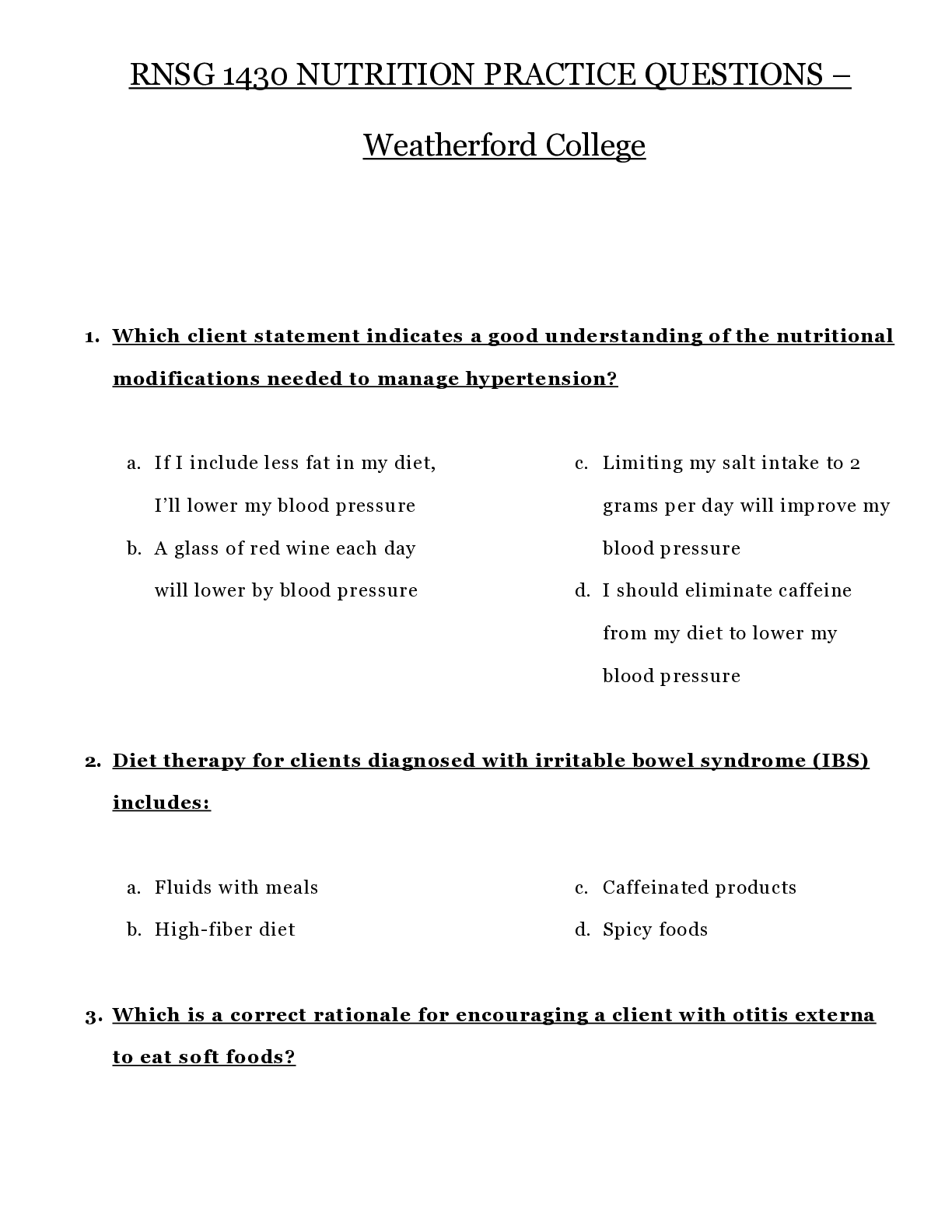
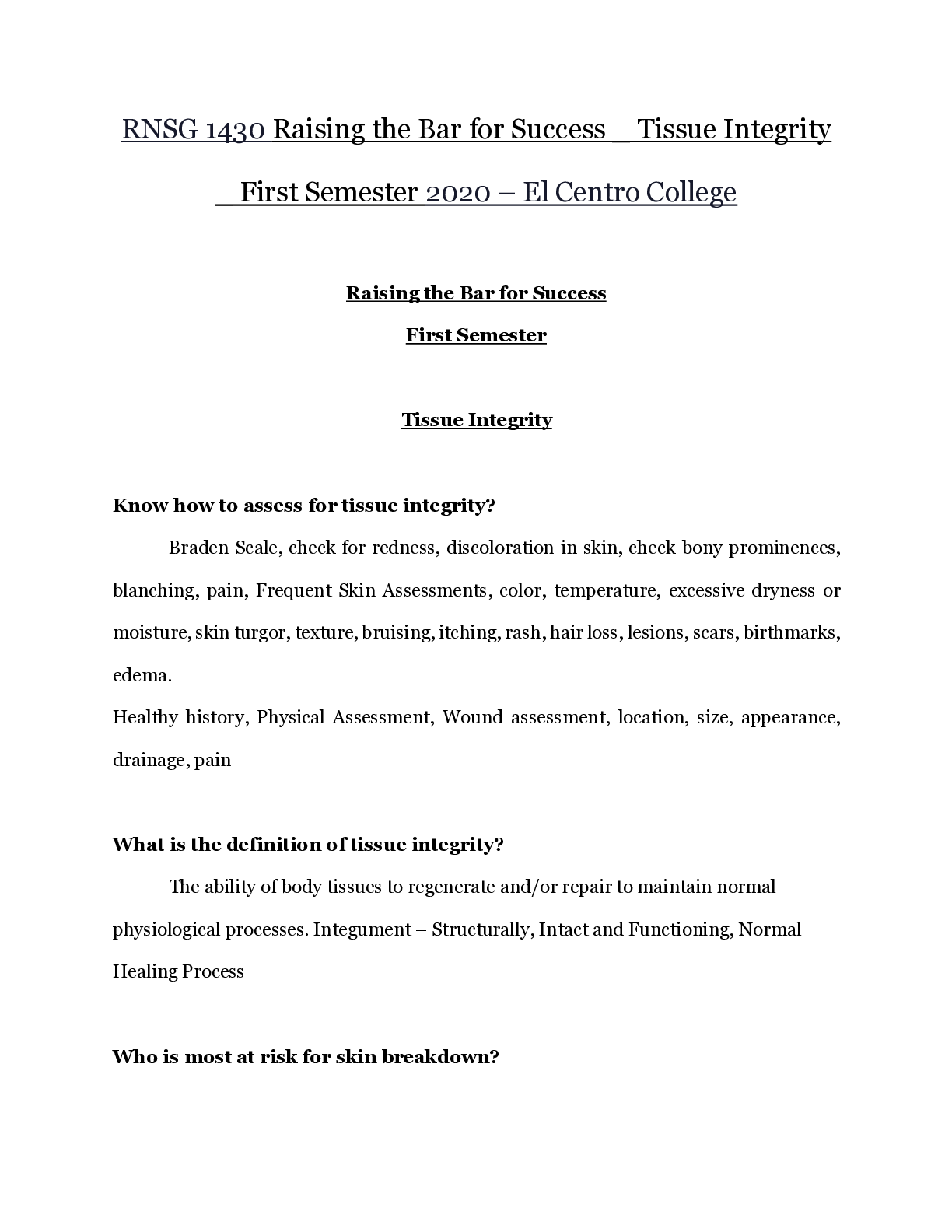
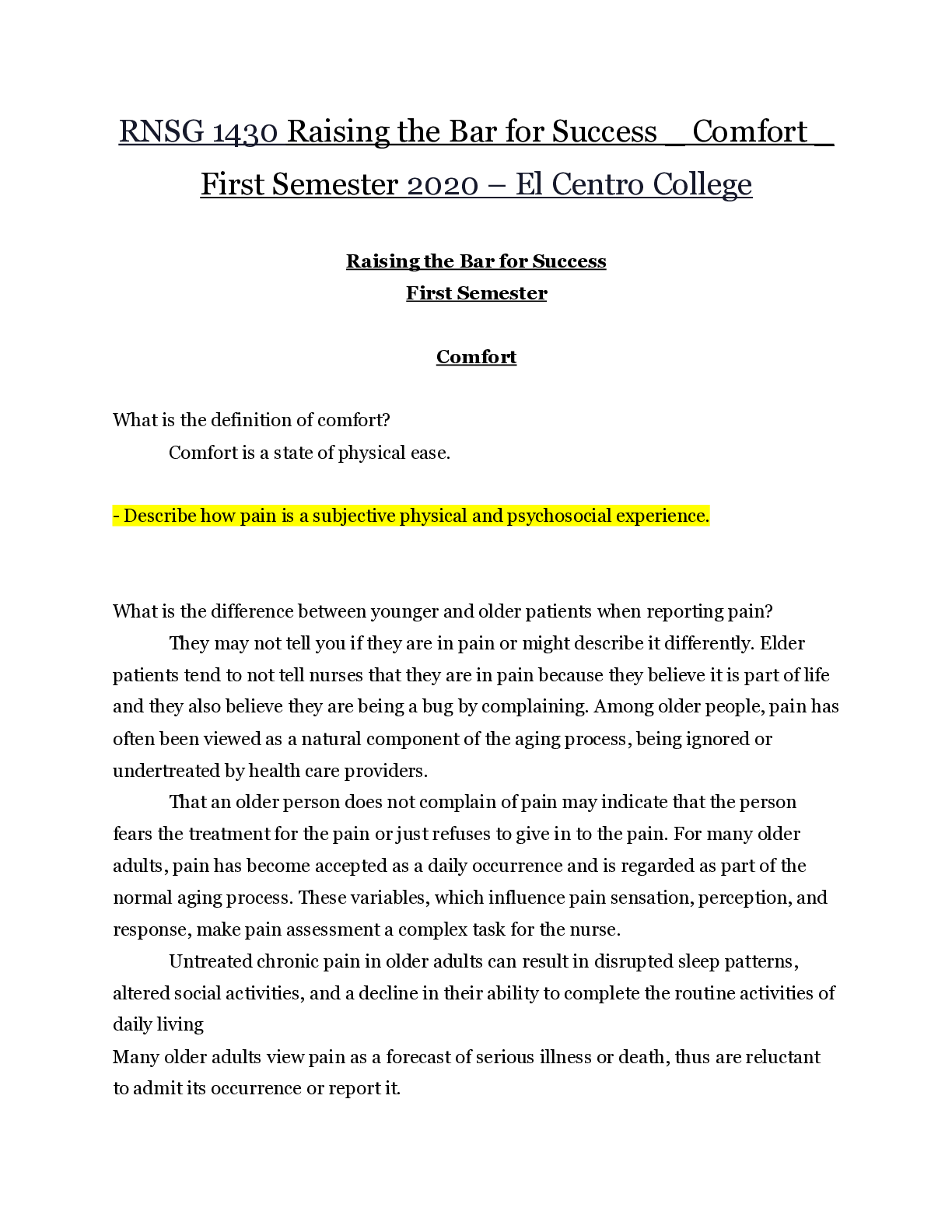
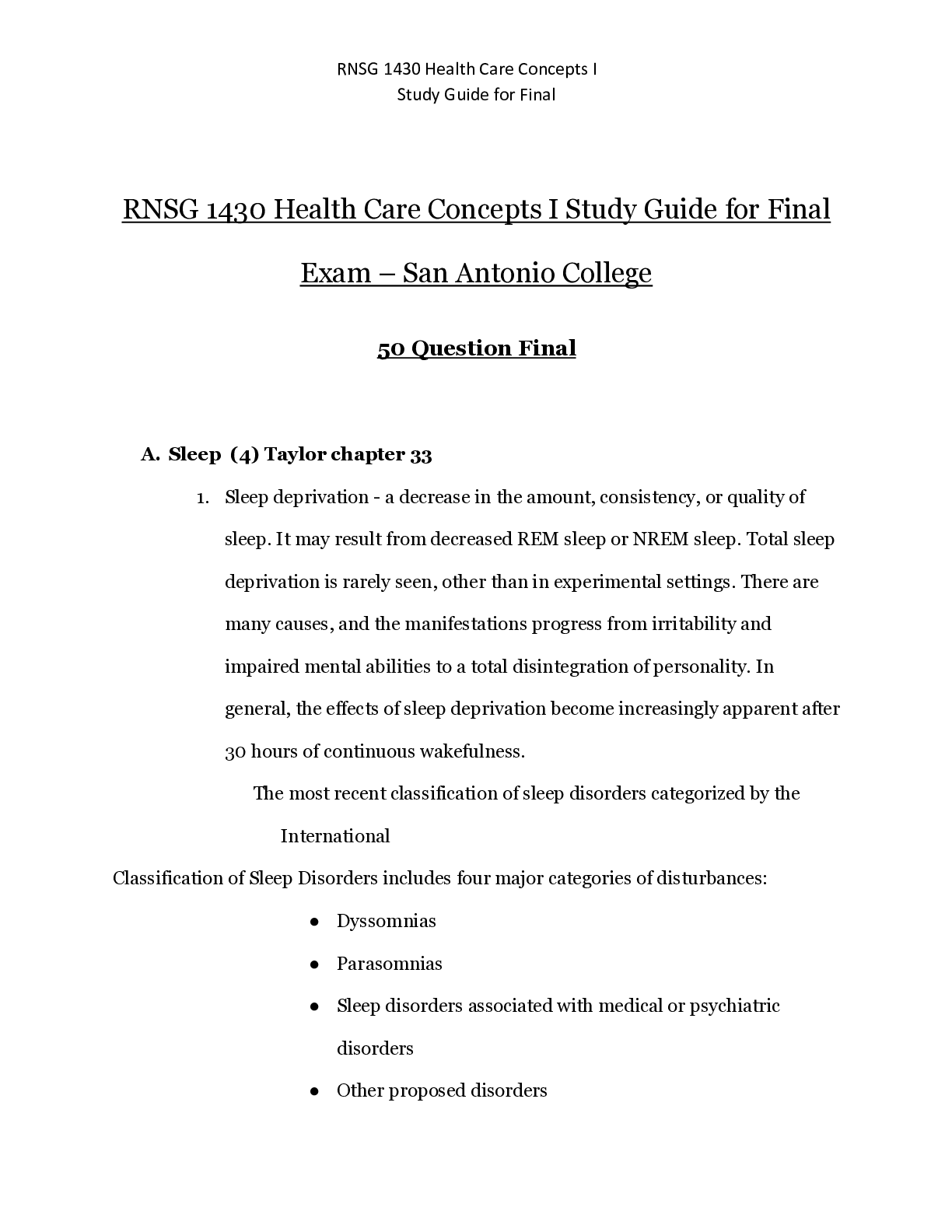
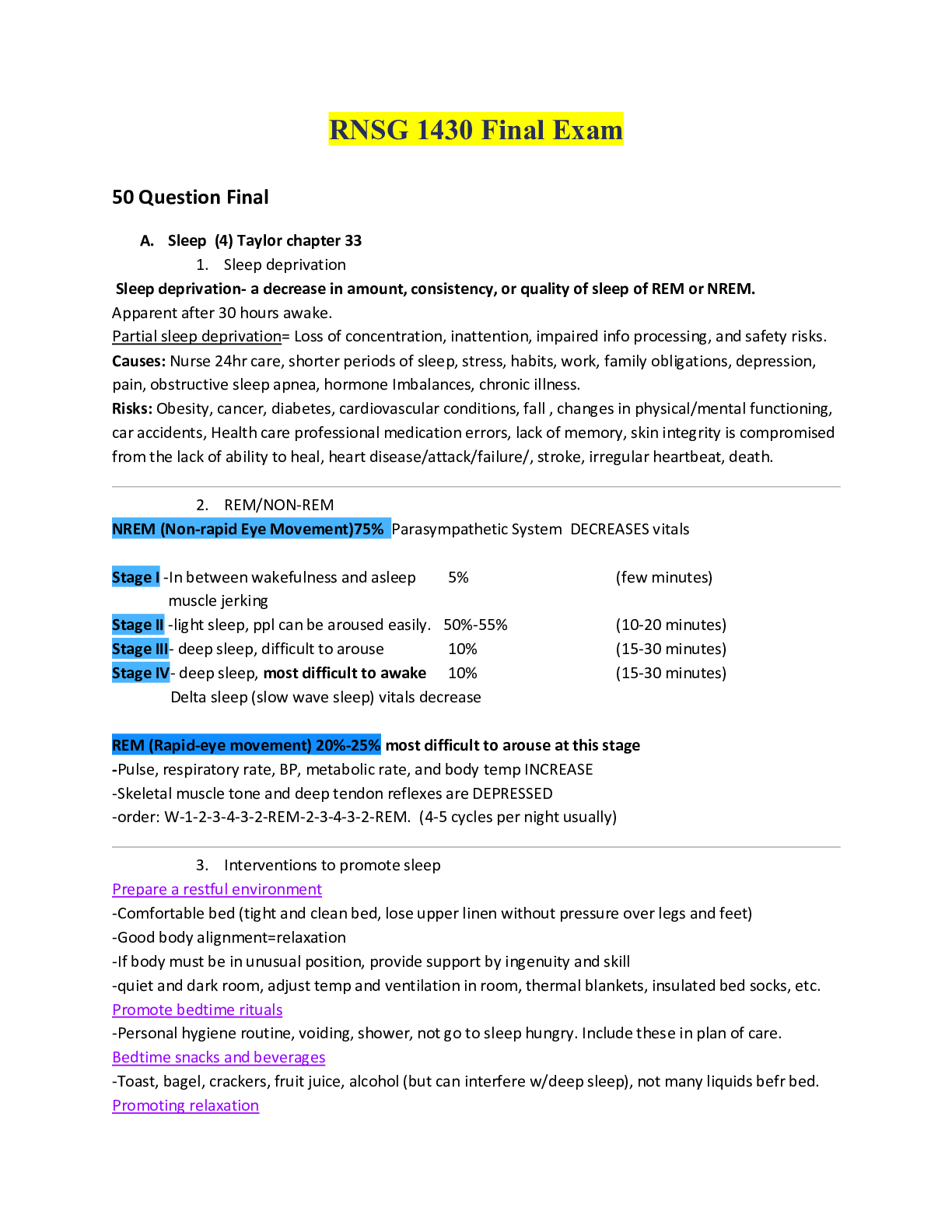
 – San Antonio College.png)

